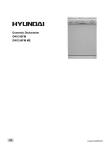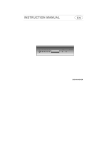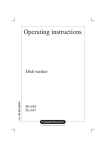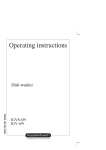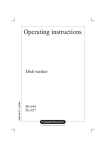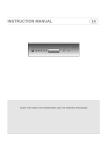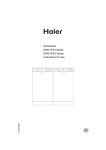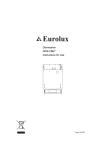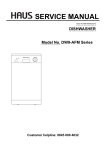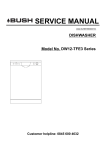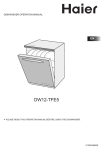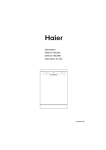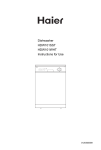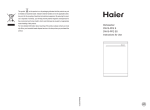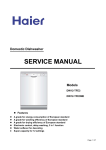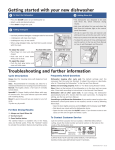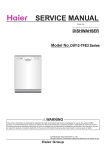Download Service Manual
Transcript
DW0907S001V2 DISHWAHSER DWF1250P DWP5012WA DWP4912W DWP4915SL Service Manual Issue Rev. Model :DWF1250P/DWP5012WA/DWP4912W/DWP4915SL Contents 1. FEATURES................................................................................................................................ 3 2.HOW TO READ THIS SERVICE MANUAL................................................................................ 4 3. SAFETY PRECAUTION ............................................................................................................ 5 3-1.AT TIME OF DELIVERY ............................................................................................................. 5 3-2.DURING INSTALLATION ............................................................................................................ 5 3-3.DURING NORMAL USE ............................................................................................................. 5 3-4.IF YOUR FAMILY INCLUDES CHILDREN ....................................................................................... 6 3-5.IF A FAULT OCCURS ................................................................................................................. 6 3-6.WHEN DISPOSING OF OLD APPLIANCES .................................................................................... 6 4. INSTALLATION ......................................................................................................................... 7 4-1.POSITIONING THE APPLIANCE .................................................................................................. 7 4-2.LEVELING THE APPLIANCE ....................................................................................................... 7 4-3.COLD WATER CONNECTION ..................................................................................................... 7 4-4.ANTI-FLOODING PROTECTION ................................................................................................. 7 4-5.DRAIN HOSE CONNECTION ...................................................................................................... 7 4-6.ELECTRICAL CONNECTION ...................................................................................................... 8 4-7. DISSEMBLE AND ASSEMBLE .................................................................................................... 9 5. PARTS AND FUNCTIONS ...................................................................................................... 16 5-1.CLOSE-UP VIEW (CONTROL PANEL)........................................................................................ 16 5-2.DISHWASHER INTERIOR ........................................................................................................ 16 6. HOW TO FILL THE SALT ....................................................................................................... 17 6-1.SALT .................................................................................................................................... 17 6-2.LOADING THE SALT INTO THE CONTAINER ............................................................................... 17 6-3.ADJUSTING SALT CONSUMPTION ........................................................................................... 17 7. HOW TO FILL RINSE AID....................................................................................................... 18 7-1.RINSE AID ............................................................................................................................ 18 7-2.LOADING THE RINSE AID ........................................................................................................ 18 8. HOW TO FILL DETERGENT DISPENSER............................................................................. 19 8-1.DETERGENT ......................................................................................................................... 19 8-2.LOADING THE DETERGENT .................................................................................................... 19 9. LOADING THE DISHWASHER............................................................................................... 20 9-1.HOW TO USE THE LOWER RACK ............................................................................................. 20 9-2.HOW TO USE THE UPPER RACK ............................................................................................. 20 1 Service Manual Issue Rev. Model :DWF1250P/DWP5012WA/DWP4912W/DWP4915SL 9-3.SHELF ................................................................................................................................. 20 10. PROGRAMME OVERVIEW .................................................................................................. 21 11. HOW TO KEEP YOUR DISHWASHER IN SHAPE ............................................................... 23 12. CLEAN AND MENTENANCE................................................................................................ 24 12-1.OVERALL CONDITION OF APPLIANCE .................................................................................... 24 12-2.FILTERS ............................................................................................................................. 24 12-3.SPRAY ARMS ...................................................................................................................... 24 13. TURNING ON THE APPLIANCE .......................................................................................... 25 14. FAULT FINDING.................................................................................................................... 27 14-1.RESOLVING MINOR PROBLEMS YOURSELF ........................................................................... 27 14-2.PROBLEMS... ..................................................................................................................... 27 14-3.DURING WASHING .............................................................................................................. 28 14-4.WITH THE DISHES,CUTLERY,ETC.......................................................................................... 29 15. MAINTENANCE SERVICES AND TROUBLE SHOOTING .................................................. 31 15-1.MANINTENANCES SERVICES ................................................................................................ 31 15-2.TROUBLE SHOOTING ........................................................................................................... 31 16. ANALYSIS OF THE COMMON BREAKDOWNS.................................................................. 32 17. TECHNICAL DATA................................................................................................................ 39 18. CIRCUIT DIAGRAM .............................................................................................................. 40 2 Service Manual Issue Rev. Model :DWF1250P/DWP5012WA/DWP4912W/DWP4915SL 1. Features z z z z z A grade for energy consumption of European standard. A grade for washing efficiency of European standard. B grade for drying efficiency of European standard. Electronic control. Super-capacity for 12 settings. Model DWF1250P DWP5012WA DWP4912W DWP4915SL Exterior Color White White White Silver Interior Color White White White White 3 Service Manual Issue Rev. Model :DWF1250P/DWP5012WA/DWP4912W/DWP4915SL 2.How to read this Service Manual The symbol on the product or on its packaging indicates that this product may not be treated as household waste. Instead it shall be handed over to the applicable collection point for the recycling of electrical and electronic equipment. By ensuring this product is disposed of correctly, you will help prevent potential negative consequences for the environment and human health, which could otherwise be caused by inappropriate waste handling of this product. For more detailed information about recycling of this product, please contact your local city office, your household waste disposal service or the shop where you purchased the product. Warning: A “warning” is used when there is danger of personal injury. Caution: A “caution” is used when there is danger that the reader, through incorrect manipulation, may damage equipment, loose data, get an unexpected result or has to restart (part of) a procedure. Notice: A “notice” provides information that is not indispensable, but may nevertheless be valuable to the reader. 4 Service Manual Issue Rev. Model :DWF1250P/DWP5012WA/DWP4912W/DWP4915SL 3. Safety precaution 3-1.At time of delivery Check packaging and dishwasher immediately for signs of transport damage. If the appliance is damaged, do not put it into use but contact your supplier or customer service without delay. Please dispose of packaging materials properly. 3-2.During installation Place the dishwasher and connect it up in accordance with the installation instructions. The dishwasher must not be connected to the electricity supply while installation is being carried out. Ensure that the domestic wiring is properly earthed. The mains electricity supply must conform to the details shown on the dishwasher nameplate. Do not connect the dishwasher to the electricity supply via an extension cable. Built-under and built-in appliances should always be installed under a continuous work surface which is attached to the adjacent cupboards, in order to ensure that the appliance is entirely stable. After the appliance has been installed,the mains plug should still be easily accessible. The plastic housing on the water inlet contains an electrically operated valve.The connecting wires are inside the inlet hose.Do not cut through this hose and do not immerse the plastic housing in water. During installation, the power supply cord must not be excessively or dangerously bent or flattened. For Switzerland only: There are no restrictions on installing the appliance between wooden or plastic walls as part of a fitted kitchen. If the appliance is not plugged into a wall socket, it must be connected to the mains via a separator for all poles within the domestic wiring system. This device must have a gap of at least 3mm between open contacts, in order to conform with relevant safety regulations. 3-3.During normal use The dishwasher must only be used by adults for the washing of household dishes and cooking utensils. This appliance cannot be installed outdoor, not even if the area in which it is installed is covered by a roof; it is also very dangerous to leave it exposed to the rain and elements. Do not place any heavy objects or stand on the door when it is open. The appliance could tip forward. The water inside the dishwasher is not suitable for drinking. Do not use solvents of any kind inside your dishwasher. They could cause an explosion danger. Open the door very carefully if the dishwasher is operating. There is a risk of water squirting out. Do not touch the heating element during or after a wash cycle. Fundamental rules to follow when using the appliance: - Never touch the dishwasher when barefoot or with wet hands or feet; - We discourage the use of extension cords and multiple sockets; - If the appliance is not operating properly or maintenance must be performed, disconnect the 5 Service Manual Issue Rev. Model :DWF1250P/DWP5012WA/DWP4912W/DWP4915SL appliance from the power supply. 3-4.If your family includes children This appliance is not intended for use by persons (including children) with reduced physical,sensory or mental capcabilities, or lack of experience and knowledge,unless they have been given supervision or instruction concerning use of the appliance by a person responsible for their safety. Children should be supervised to ensure that they to not play with the appliance. Keep detergents out of the reach of children, who must also be kept away from the dishwasher when it is open. 3-5.If a fault occurs If the appliance malfunctions, turn off water supply to the appliance and disconnect the plug from the wall socket. Then, consult the section entitled, "Fault finding" .If you cannot solve the problem, contact a service center. Only specialised personnel are authorised to make repairs. If the supply cord is damaged ,it must be replaced by the manufacture ,its service agent of similarly qualified persons in order to avoid a hazard. To maintain the EFFICIENCY and SAFETY of this appliance,we recommend: - call only the Service Centers authorized by the manufacturer. - always use original Spare Parts. 3-6.When disposing of old appliances Appliances which are no longer being used must be made inoperable by cutting the power supply cord and removing the door lock. Take the appliance to a designated waste disposal center. Dangerous voltage Warning: Children could get locked in the appliance (risk of suffocation) or get stuck in other positions. Therefore: Remove the mains plug, cut the mains wire and set aside. Damage the door lock so that the door can no longer be closed. 6 Service Manual Issue Rev. Model :DWF1250P/DWP5012WA/DWP4912W/DWP4915SL 4. Installation 4-1.Positioning the appliance Positioning the appliance in the desired location. The back should rest against the wall behind it, and ts, along the adjacent cabinets or wall. The dishwasher is equipped with water supply and drain hoses that can be positioned to the right or the left to facilitate proper installation. 4-2.Leveling the appliance Once the appliance is positioned, adjust the feet (screwing them in or out) to adjust the dishwasher,making it level. In any case, the appliance should not be inclined more than 2°. If the appliance is level, it will help ensure proper performance. 4-3.Cold water connection Connect the water supply hose to a threaded 3/4 (gas) connector, making sure that it is fastened tightly in place (DWF1250P/DWP5012WA/ DWP4912W see fig.A). Some models are fitted with an "Aquastop" water supply hose (DWP4915SL see fig.B) in which the small filter is already housed in the threaded end. If the water pipes are new or have not been used for an extended period of time, let the water run to make sure that the water is clear and free of impurities. If this precaution is not taken, there is a risk that the water inlet can get blocked and damage the appliance. fig.A fig.B Warning: The appliance is to be connected to the mains water using new hose sets. Old hose sets should not be reused. 4-4.Anti-Flooding protection The dishwasher is equipped with a system that stops the supply of water in the event of a problem with the water supply hose or leaks within the unit, in order to prevent damage to your home. If for any reason the box containing the electrical components happens to get damaged, turn off the power supply and unplug the appliance immediately. In order to guarantee that the anti-flooding feature operates properly, box "A" with the water supply hose must be attached to the water supply tap as shown in Fig. B. If the length of the hose is not adequate to make a proper connection, the hose must be replaced with one which is long enough. This hose is available upon request from specialised retailers and approved service centres. 4-5.Drain hose connection Insert the drain hose into a drain pipe with a minimum diameter of 4cm, or let it run into the sink, making sure to avoid bending or crimping it. If necessary, fit a syphon trap (U-bend) with a connecting piece for the drain hose (fig.C). The free end of the hose must be at a height between 40 and 100 cm and must not be immersed in water. 7 Service Manual Issue Rev. Model :DWF1250P/DWP5012WA/DWP4912W/DWP4915SL fig.C Attention: The connecting piece for syphon trap (U-bend) must be solidly fastened to the wall to prevent the drain hose from moving and allowing water to spill outside the drain. 4-6.Electrical Connection After making sure that the voltage and frequency values for the current in the home correspond to those on the rating plate (located on the stainless steel inner door of the appliance) and that the electrical system is correct for the maximum voltage on the rating plate, insert the plug into an electrical socket which is earthed properly (the earthing of the appliance is a safety requirement mandated by law).If the electrical socket to which the appliance must be connected is not appropriate for the plug, replace the whole cable, rather than using adaptors or the like as they could cause overheating and burns. Caution: The dishwasher plug must be accessible even when the appliance is installed as a built-in unit so that maintenance can be done safely. Electrical Connection (Uk Only) For your safety please read the following information. Warning: This appliance must be earthed. The appliance must be connected to a 220-240 volts 50 cycle AC supply by means of a three pin socket, suitably earthed and should be protected by a 13 amp fuse in the plug. The appliance is supplied with a rewireable 13 amp 3-pin plug fitted with a 13-amp fuse. Should the fuse require replacement, it must be replaced with a fuse rated at 13 amp and approved to BS1362. If the mains plug is unsuitable for the socket outlet in your home or is removed for any other reason,then the cut off plug should be disposed of safely to prevent the hazard of electric shock. Remove the fuse before disposal. There is a danger of electric shock if the cut off plug is inserted into any 13-amp socket outlet. 8 Service Manual Issue Rev. Model :DWF1250P/DWP5012WA/DWP4912W/DWP4915SL How to wire a 13 amp plug. Important The wires in the mains lead on this appliance are coloured in accordance with the following code: Green and Yellow-Earth Blue-Neutral Brown-Live As the colours may not correspond with the markings identifying the terminals in your plug proceed as follows. The green and yellow wire must be connected to the terminal in the plug which is marked with the letter E or with the earth symbol or coloured green and yellow. The blue wire must be connected to the terminal marked N. The brown wire must be connected to the terminal marked L. You must make sure the lead is firmly secured under the cord clamp. 4-7. Dissemble and assemble Tools screwdriver Dissemble and assemble for dishwasher components cross-screwdriver Dissemble and assemble for dishwasher components blade used for unpacking electric drill used for drill holes while installation spanner used for combine the inlet hose 9 Service Manual Issue Rev. Model :DWF1250P/DWP5012WA/DWP4912W/DWP4915SL How to remove the top of your dishwasher Freestanding dishwasher can also be used as built-in, according to following processes: 10 Service Manual Issue Rev. Model :DWF1250P/DWP5012WA/DWP4912W/DWP4915SL 00050 01202 Built In Dishwasher: fixing on top or Built In Dishwasher: fixing on side 11 Service Manual Issue Rev. Model :DWF1250P/DWP5012WA/DWP4912W/DWP4915SL Side panel disassembly Use the cross-screwdriver to drive two screws which are on left top of machine, off side panel. Use the cross-screwdriver to drive five screws which are in left back of machine, off the right side panel. Open the door, use the cross-screwdriver to drive four screws which are in left front, off the right side panel. 12 Service Manual Issue Rev. Model :DWF1250P/DWP5012WA/DWP4912W/DWP4915SL Adjustable softener with reed disassembly Lay the dishwasher on the floor, then remove the bottom cover, pull out the connector of the salt adding valve and the low salt switch. Remove the three clips for fixing the rubber connect pipe, then pull out the rubber pipe. Open the out door, you can see the salt adding cover, then circumrotate the cover anticlockwise and screw it Circumrotate the fixing set of the water softer anticlockwise, then screw id down(you can use the disassembly tool to operate) Then take the water softer down accordingly. 13 Service Manual Issue Rev. Model :DWF1250P/DWP5012WA/DWP4912W/DWP4915SL Heater disassembly Remove the two self-drilling bolts for fixing the heater bracket from the middle bar, then remove the heater. Pull out the three connector of the heater. Remove the pipe hoop. Remove the connector pipe of the hot pump and the middle hot pump ,then can take the heater down. 14 Service Manual Issue Rev. Model :DWF1250P/DWP5012WA/DWP4912W/DWP4915SL Detergent dispenser disassembly Open the door, disassemble the outer door (Accord to the disassembly step) Close the door, use screwdriver to drive the 6 screws of Detergent Dispenser off, pull the wire out, then open the door, and get the Detergent Dispenser off. 15 Service Manual Issue Rev. Model :DWF1250P/DWP5012WA/DWP4912W/DWP4915SL 5. Parts and Functions 5-1.Close-up view (control panel) C A B A “ON-OFF” Button B Programme Button C Programme Indicator 5-2.Dishwasher interior i a j c e d b k f g h a Upper Rack b Lower Rack c Top Spray Arm d Silverware Basket e Bottom Spray Arm f g h i j k Salt Container Cap Washing Filter Detergent and Rinse Aid Dispenser Water Inlet Hose Drain Hose Power Supply Cord 16 Service Manual Issue Rev. Model :DWF1250P/DWP5012WA/DWP4912W/DWP4915SL 6. How to fill the salt 6-1.Salt The hardness of the water varies from place to place. If hard water is used in the dishwasher, deposits will form on the dishes and utensils. The appliance is equipped with a special softener that uses a salt specifically designed to eliminate lime and minerals from the water. 6-2.Loading the salt into the container Always use salt intended for use with dishwashers. The salt container is located beneath the lower rack and should be filled as follows: According to the “Water Hardness Tabel”, you can calculate the time of use, then load the salt . Remove the lower rack and then unscrew and remove the cap from the salt container. If you are filling the container for the first time, fill it with water. Place the end of the funnel (supplied) into the hole and introduce about 2 kg of salt. It is normal for a small amount of water to come out of the salt container. Carefully screw the cap back on. Important: To prevent the formation of rust, load the salt just before beginning a wash cycle. 6-3.Adjusting salt consumption The dishwasher is designed to allow for adjusting the amount of salt consumed based on the hardness of the water used.This is intended to optimize and customize the level of salt consumption so that it remains at a minimum. To adjust salt consumption, proceed as follows: Unscrew the cap from the salt container; There is a ring on the container with an arrow on it (see figure to the side), If necessary, rotate the ring in an anticlockwise direction from the "-" setting towards the "+" sign, based on the hardness of the water being used. It is recommended that adjustments be made in accordance with the following table: Water Hardness Clarke Level degrees ºdH mmol/l Selector position Salt consumption (Grams/cycle) Autonomy (cycles/2kg) 1 2 0-14 14-36 0-17 18-44 0-1,7 1,8-4,4 / "-" 0 20 / 60 3 36-71 45-89 4,5-8,9 Middle 40 40 4 >71 >89 >8,9 60 25 "+" 17 Service Manual Issue Rev. Model :DWF1250P/DWP5012WA/DWP4912W/DWP4915SL 7. How to fill rinse aid 7-1.Rinse aid This product makes dishes sparkle and helps them to dry without spotting. The dispenser is located on the inside panel of the door . 1 When the low rinse aid indicator “ 1 ” is bright, it means the rinse aid is low, you must load rinse aid . Low 7-2.Loading the rinse aid Regardless of the type of detergent dispenser installed on your appliance, you must proceed as indicated below when loading the rinse aid. To open the dispenser, turn the "2" cap in an anti-clockwise direction and then pour in the rinse aid, making sure not to overfill. The amount of rinse aid used for each cycle can be regulated by turning the " 3" dose adjustor, located beneath the "2" cap, with a screwdriver. There are 6 different settings; the normal dosage setting is 3. Full 2 3 Important: Proper dosage of the rinse aid improves drying. If drops of water remain on the dishes or spotting occurs, the dosage adjuster should be turned to a higher setting. If the dishes have white streaks, turn the dosage adjuster to a lower setting. 18 Service Manual Issue Rev. Model :DWF1250P/DWP5012WA/DWP4912W/DWP4915SL 8. How to fill detergent dispenser 5 8-1.Detergent Detergent specifically intended for use with dishwashers must be used. The dispenser must be refilled before the start of each wash cycle following the instructions provided in the "Programme overview". The detergent dispenser is located on the inside panel of the door. 4 8-2.Loading the detergent To open the " 4 " cover on the dispenser, press the " 5 "button. The detergent for the wash cycle should be poured into the " 6 " compartment. The detergent for the pre-wash cycle should be poured into the “ 7 ” compartment. After the detergent has been placed in the dispenser, close the cover and press down until it clicks in place. 7 6 Notice: To facilitate closing the cover, remove any excess detergent on the edges of the dispenser. Notice: The usage of 3 in 1 or similar tablets is forbidden when Rapid Wash Heat wash and Soak programmes are selected. Warning: Do not place the tablets in the tub or the cutlery basket as this will result in poorer wash results. The tablets should be placed in the detergent doser. 19 Service Manual Issue Rev. Model :DWF1250P/DWP5012WA/DWP4912W/DWP4915SL 9. Loading the dishwasher Before placing the dishes in the dishwasher, remove larger food particles to prevent the filter from becoming clogged, which results in reduced performance. If the pots and pans have baked-on food that is extremely hard to remove, we recommend that they are soaked before washed. This will eliminate the need for extra wash cycles. Pull out the rack to load the dishwasher. Normal daily load 9-1.How to use the lower rack We recommend that you place the most difficult to clean items on the bottom rack: pots, pans, lids, serving dishes and bowls, as shown in the figure to the right. It is preferable to place serving dishes and lids on the sides of the racks in order to avoid blocking the rotation of the top spray arm. Pots, serving bowls, etc. must always be placed face down(see fig.C) . Deep pots should be slanted to allow the water to flow out. fig.C Warning: knives and other utensils with sharp points must be loaded in the basket with their points down or placed in a horizontal position. 9-2.How to use the upper rack The upper rack is designed to hold more delicate and lighter dishware, such as glasses, cups and saucers, plates, small bowls and shallow pans (as long as they are not too dirty). Position the dishes and cookware so that they do not get moved by the spray of water. The upper rack can be adjusted for height by using the knobs located on both sides of the rack itself (see fig.D). fig.D Adjust the upper basket to the higher level and you have more space to accommodate those taller pans and trays in the bottom basket. 9-3.Shelf Lean tall glasses and those with long stems against the shelfnot against other items to be washed. Place glasses, cups and small bowls on the additional cup rack. The additional cup rack can be swivelled in or out as required (see fig.E). 20 fig.E Service Manual Issue Rev. Model :DWF1250P/DWP5012WA/DWP4912W/DWP4915SL 10. Programme overview Type of crokery Wash Type of e.g.china, prografood pots/pans, mme cutlery, remains glasses, etc Amount of food remains Condition of food remains Description of cycle Pre-wash with warm water. Intensive Wash Nondelicate Extended wash at 70°C. Soups, Rinses with cold water. casseroles, sauces, potatoes, a lot stuck Rinse with hot water. on hard Drying. Pre-wash use cold water. pasts, rice, Extended wash at 55°C. eggs, roast Rinse with cold water. or fried food. Normal Wash Rinse with hot water. Drying. Soups, potatoes, pasta, rice, Light Wash (EN50242) Mixed Rapid wash Soak Pre-wash use cold water. a little loosely Extended wash at 50°C. attached Rinse with cold water. eggs, roast Rinse with hot water. or fried food. Drying. Coffee, cakes, milk, sausage, cold drinks, salads Very loosely Short wash at 40°C. little attached Cold rinse. Rinse off if the dishes have been Short cold wash to pre- stacked for several days in the dish- vent food residue from washer prior to washing. drying on the dishes . 21 Service Manual Issue Rev. Model :DWF1250P/DWP5012WA/DWP4912W/DWP4915SL Detergent Rinse Prewash Exten- Aid ded Duration in minutes Energy Water consu- consu- mption mption in kWh in litres Wash 5g 25g 112 1.62 18 5g 25g 102 1.24 16 5g 25g 162 1.05 15 31 0.40 9 12 0.02 3 (*) 15g * EN50242 test with rinse aid setting 5 22 Service Manual Issue Rev. Model :DWF1250P/DWP5012WA/DWP4912W/DWP4915SL 11. How to keep your dishwasher in shape After Every Wash After every wash, turn off the water supply (not necessary for models with “Aquastop” ) the appliance and leave the door slightly ajar so that moisture and odors are not trapped inside. Remove the plug Before cleaning or performing maintenance, always remove the plug from the socket. Do not run risks. No solvents or Abrasive Cleaning Products To clean the exterior and rubber parts of the dishwasher, do not use solvents or abrasive cleaning products. Rather, use only a cloth and warm soapy water. To remove spots or stains from the surface of the interior, use a cloth dampened with water and a little while vinegar, or cleaning product made specifically for dishwashers. Moving the Appliance If the appliance must be moved, try to keep it in a vertical position. If absolutely necessary, it can be positioned on its back. Seals One of the factors that cause odors to form in the dishwasher is food that remains trapped in the seals. Periodic cleaning with a damp sponge will prevent this from occurring. The door should not be left in the open position since this could present a tripping hazard. When You Go on Holiday When you go on holiday, it is recommended that you run a wash cycle with the dishwasher empty and then remove the plug from the socket, turn off the water supply and leave the door of the appliance slightly ajar. This will help the seals last longer and prevent odors from forming within the appliance. 23 Service Manual Issue Rev. Model :DWF1250P/DWP5012WA/DWP4912W/DWP4915SL 12. Clean and mentenance Regular inspection and maintenance of your appliance helps to prevent problems from occurring.This saves time and aggravation.You should therefore carefully inspect the inside of your dishwasher from time to time. 12-1.Overall condition of appliance Check that no grease or scale has accumulated on the inside of the dishwasher. If you discover any deposits: Clean the interior of the dishwasher thorughly with a detergent solution. 12-2.Filters The filters “ 8”,“ 9” prevent larger particles of food in the water from reaching the pump.These particles may occasionally block the filters. When the appliance has finished washing, check the filters for particles of food and, if required, clean. After undoing the coarse micro-filter “ 8 ” , the filter unit “ 9” can be removed. Remove any particles of food and rinse the filters under running water. Insert the filter unit “ 9 ” and tighten the coarse microfilter. 8 9 12-3.Spray arms Lime and remnants of food in the washing water can block the nozzles in the spray arms “ 10 ” and “ 11 ” and the arm mountings. Inspect the nozzles in the spray arms for blocked holes due to remnants of food. If necessary, pull the lower arm “ 11 ” upwards and lift it off. Unscrew the upper spray arm “ 10 ”. Clean both spray arms under running water. Refit the spray arms. Ensure that the lower arm has locked into place and the upper one is screwed tight. 24 10 11 Service Manual Issue Rev. Model :DWF1250P/DWP5012WA/DWP4912W/DWP4915SL 13. Turning on the Appliance Switching the dishwasher ON Turn on the tap. Close the door after loading the appliance Set ON-OFF button “ A ” to ON. All the programme indicators “C1,C2,C3,C4,C5 ” light . Press programme button “B1” , programme indicator“ C1” light. After 3 seconds, the programme indicator “ C1” bcomes to blink and the dishwasher beeps one time, then the programme starts automatically. A C1 C2 C3 C4 C5 B1 End of programme Six beeps will indicate that the wash cycle has finished and all the programme indicators light. Switching the dishwasher OFF Several minutes after the programme has ended: Set main switch “A” to OFF. Open the door . Turn the water tap off. (Does not apply when Aquastop unit has been fitted) Remove dishes, etc. when they have cooled down. When the appliance is already underway press the button "A" for 3 seconds, all of the settings will be cancelled. Interrupting the programme Open the door. Caution! There is a risk of water squirting out from inside the appliance. Do not open the door fully until spray arm has stopped rotating. When you open the door, the dishwasher will beep ten times every thirty seconds. If the appliance has already heated up or the hot water was switched ON and then the appliance door opened, leave the door ajar for several minutes and then close. Otherwise, the appliance door may open due to expansion. Cancelling or modifying a cycle A cycle that is underway can be modified if it has only been running for a short time. Otherwise, the detergent may have already been used, and the appliance may have already drained the wash water. If this is the case, the detergent dispenser must be refilled ( see the paragraph entitled, “ Loading the detergent ”). To modify a cycle that is already underway, follow the instructions contained in the paragraph entitled "Reset drain function", and select the programme you wish (see the paragraph entitled, "Switching the dishwasher ON") 25 Service Manual Issue Rev. Model :DWF1250P/DWP5012WA/DWP4912W/DWP4915SL Reset drain function You can use "Reset drain function"to stop the washing cycle under running by pressing and holding the "B1" and "B3" for 3 senconds, and the appliance will stop after a few minutes drain phase. B1 B3 26 Service Manual Issue Rev. Model :DWF1250P/DWP5012WA/DWP4912W/DWP4915SL 14. Fault finding 14-1.Resolving minor problems yourself Experience has shown that you can resolve most problems that rise during normal daily usage yourself,without having to call out a service engineer.Not only does this save costs,but it also means that the appliance is available for use again that much sooner. The following list of common occurrences and their remedies should help you identify the causes of most problems. 14-2.Problems... ...when the appliance is switched on Appliance does not start up Fault with fuse in mains electricity supply. Plug not inserted in wall socket. Appliance door not closed properly. Programme button has not been pressed. Water tap not turned on. Blocked strainer in water intake hose. - The strainer is situated in the Aquastop or supply-hose connection. Caution: Do not forget that repairs should only be carried out by a qualified specialist. Improper repairs can lead to considerable equipment damage as well as danger to the user. ...with the appliance itself C1 C2 Error display on the time-remaining indicator When the programme indicators “C1,C2” blink. Have you checked whether: the door is closed properly. When the programme indicators “ C1,C4” blink. Have you checked whether: the drain hose is too low. When the programme indicators “ C1,C3,C4” blink. Have you checked whether: the drain hose is crimped or bent. the drain hose is too high. When the programme indicators “C1,C2,C3” blink. Have you checked whether: the water is turned on and the hose is connected properly; the water supply to the house is on and has sufficient pressure; the water supply hose is crimped or bent; the filter for the water supply hose is clogged. the drain hose is too low. 27 C4 C1 C1 C3 C4 C1 C2 C3 Service Manual Issue Rev. Model :DWF1250P/DWP5012WA/DWP4912W/DWP4915SL If you take all these checks and the dishwasher still does not function or your dishwasher have any other error display, you can power the dishwasher OFF, and wait a few minutes. You can power the dishwasher on, try it again , if the dishwasher still does not function and/or the problem persists, contact the nearest authorised service center and provide them with the following information: the nature of the problem. the model type number (Mod...) And the serial number (S/N...), which are indicated on the plate located on the side of the inner part of the door. Lower spray arm rotates with difficulty Spray arm is blocked by small items or food remains. Lid in detergent compartment cannot be closed Detergent compartment has been overfilled. Mechanism is clogged with remnants of detergent. Indicator lamps do not extinguish after washing has finished Main switch is still set to ON. Remnants of detergent stuck inside dispenser Compartment was damp when it was filled up with detergent. Compartment must be dry before detergent is added. Water remains inside appliance after programme has ended Blockage or kind in drainage hose. Pump is jammed. Filters are blocked. The programme is still running. Wait for the programme to end . 14-3.During washing Unusual amount of foam is creased Normal washing up liquid has been poured into the rinse-aid container. Remove any spilled rinse aid with a cloth as it could otherwise lead to excessive foaming during the next washing cycle. Appliance stops suddenly while washing is taking place Cut off electricity supply to appliance. Water supply has been interrupted. Knocking sound can be heared while washing is taking place A spray arm is knocking against the dishes inside the appliance. 28 Service Manual Issue Rev. Model :DWF1250P/DWP5012WA/DWP4912W/DWP4915SL Rattling sound can be heared while washing is taking place Crockery has not been stacked properly inside the appliance. Knocking sound coming from inlet valves This is caused by the way the water pipes have been laid and it has no effect upon the way the appliance functions. There is no remedy for this. 14-4.With the dishes,cutlery,etc. Remnants of food are stuck to the dishes, cutlery,etc. Dishwasher was not loaded properly. Jets of water could not reach all parts of the dishes, etc. Too many items in the rack. Items in the rack were touching each other. Not enough detergent was added to dispenser. Selected wash programme was not intensive enough. Rotation of spray arm was obstructed by dishes, etc. Nozzles in spray arm are blakcked by remnants of food. Filters are blacked. Filters have been incorrectly fitted. Waste-water pump is jammed. Plastic items are discoloured Not enough detergent was added to dispenser. Detergent has insuffcient bleaching properties. Use a detergent containing a chemical bleaching agent. White stains are left on crockery, glasses have a milky appearance Not enough detergent was added to dispenser compartment. Amount of rinse-aid was set too low. Although water is quite hard, no salt has been put in appliance. Water softener was set too low. Lid on salt container is not screwed tight. If you used a phosphate-free detergent , try a detergent containing phosphates and compare results. Dishes,cultlery,etc.have not been dried Selected programme did not include drying function. Amount of rinse-aid was set too low. Items were removed from dishwasher too soon. Glasses have a dull appearance Amount of rinse-aid was set too low. 29 Service Manual Issue Rev. Model :DWF1250P/DWP5012WA/DWP4912W/DWP4915SL Tea stains or traces of lipstick have not been completely removed Detergent does not have a sufficient bleaching effect. Washing temperature was set too low. Traces of rust on cutlery Cutlery is not sufficiently rustproof. Salt content in washing water is too high. - Lid on salt container is not screwed tight. - Too much salt was spilt while filling container. Glasses become clouded and discoloured; coating cannot be wiped off Unsuitable detergent was used. Glasses are not dishwasher-proof. Smears left behind on glasses and cutlery; glasses have acquired a metallic appearance Amount of rinse-aid set too high. 30 Service Manual Issue Rev. Model :DWF1250P/DWP5012WA/DWP4912W/DWP4915SL 15. Maintenance Services and Trouble Shooting 15-1.manintenances services It may occur that the dishwasher does not function or does not function properly Before calling for assistance,Iet us see what can be done first :have you forgotten to press one of the buttons or to perfom an essential operation? 15-2.trouble shooting Trouble Door switch Sensor Leak Drain pump Water Water trouble trouble trouble trouble supply overflow trouble trouble Blink Blink Blink Blink Blink Blink Cycle Blink Blink Blink Blink Blink Blink Blink Blink Beep V V V 31 Blink Blink V V V Service Manual Issue Rev. Model :DWF1250P/DWP5012WA/DWP4912W/DWP4915SL 16. Analysis of the common breakdowns Door switch trouble Phenomenon: the dishwasher does not work N Whether door is closed Close the door Y check if door flap is OK N Replace it Y Dismantle the door case and using N avometer to measure if the two Change the door switch terminals of door switch is on. Y Cable or the controller board is broken 32 Service Manual Issue Rev. Model :DWF1250P/DWP5012WA/DWP4912W/DWP4915SL water supply trouble Phenomenon: water level cannot reach the required location N Whether water is flowing in the hose Turn on the stopcock Whether the stopcock is turned on Y Whether solenoid valve is N working measure whether solenoid valve is electrified Y Y Change the solenoid valve Check whether the water Y intake velocity is too slow user’s water pressure is too low N Whether water switch is ok level N Y Cable or the controller board is broken 33 Change water level switch Service Manual Issue Rev. Model :DWF1250P/DWP5012WA/DWP4912W/DWP4915SL Drain pump trouble Phenomenon: water cannot be drained Repair the pipeline and drain pump Y Whether drain pump Whether the pipeline and Y drain pump was blocked is working N N Whether drain pump The drain hose is too is electrified high Y N Cable or the controller The drain pump is broken board is broken 34 Service Manual Issue Rev. Model :DWF1250P/DWP5012WA/DWP4912W/DWP4915SL Heating element trouble Phenomenon: Heating element cannot work N Whether socket connector is connected well Connect it well Y Check the resistance between N Replace the heater the heater resistor Y Check whether the circuit Y between the two teminals is open N The cable or the controller board is suspected damaged 35 Connect the two terminals well Service Manual Issue Rev. Model :DWF1250P/DWP5012WA/DWP4912W/DWP4915SL Water overflow trouble Phenomenon: drain pump keep on working Whether water is deposited is Y the bottom case Whether water flows out of Bottom case is N the water overflow conduit leaking Y N Check whether the water level switch is closed Y Whether the water overflow swich is ok N change water overflow switch cable or the controller board is broken Y the controller boardr or cable is broken 36 N change the water level switch Service Manual Issue Rev. Model :DWF1250P/DWP5012WA/DWP4912W/DWP4915SL Power supply trouble Phenomenon: dishwasher cannot work N check whether the power connector Connect it properly is in position Y N check whether the circuit the cable or the controller board between the two terminals is should be suspected open Y replace the power switch 37 Service Manual Issue Rev. Model :DWF1250P/DWP5012WA/DWP4912W/DWP4915SL Leak trouble Phenomenon: dishwasher stop working Y check whether the drain hose is too low Drive up the drain hose properly N check whether the Y water Change the water level switch level switch is damage N replace the PCB 38 Service Manual Issue Rev. Model :DWF1250P/DWP5012WA/DWP4912W/DWP4915SL 17. Technical data Width 60 cm Depth 60 cm Height 85cm Capacity 12 standard place settings Mains water pressure 0.03-0.6MPa Power voltage 220-240V~ 50Hz Total absorbed power 1950W Maximum current intensity 10A 39 Service Manual Issue Rev. Model :DWF1250P/DWP5012WA/DWP4912W/DWP4915SL 18. Circuit Diagram A: Wiring box B: Door switch C: Water level switch D: Drain pump motor E: Dispenser F: Softener valve G: Overflow switch H1: Inlet valve H2: Inlet valve with Aquastop I: Washing pump motor 40 J: Temperature limiter K: Heater L: Relay M: Temperature Sensor Service Manual Issue Rev. Model :DWF1250P/DWP5012WA/DWP4912W/DWP4915SL Sincere Forever Haier Group Haier Industrial Park,No.1 Haier Road 266101, Qingdao, China http://www.haier.com 41










































